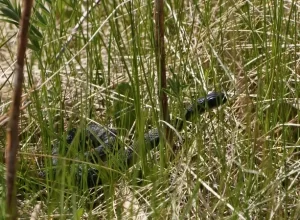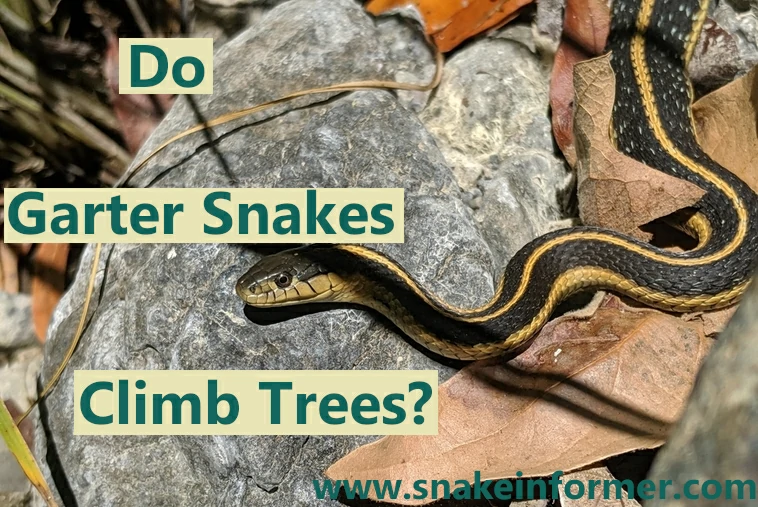Garter snakes are among the most common snakes in North America. They are usually found in forest areas but can exploit many habitats.
Although largely terrestrial, garter snakes occasionally climb low trees or shrubs for various reasons, such as hunting, basking in the sun, escaping predators, and avoiding dangers on the ground such as flooding.
These snakes are capable climbers and can go up a tree within a few minutes, sometimes remaining there for hours before descending to the ground.
Garter Snakes Occasionally Climb Trees
Garter snakes have a very wide distribution, and can be found in various environments, from wetlands to forests, to mountainous areas, to dry regions.
For this reason, these snakes have adapted to effectively move through a wide variety of habitats.
Garter snakes can swim, move across sand, and even climb short trees and shrubs, with relative ease.
While mostly terrestrial, they can utilize a broad range of habitats, at least occasionally.

In one study, researchers studying Red-sided garter snakes (Thamnophis sirtalis parietalis) noted that the snakes climbed into stunted aspen and willow trees.
The snakes often returned to the ground within a few minutes, but some remained in the tree for over an hour.
6 Reasons Why Garter Snakes Climb Trees
There are several reasons why garter snakes may climb trees. They may be escaping a predator, busking in the sun, or even searching for a meal.
Here are 6 reasons why garter snakes climb trees:
1. Hunting
Like all snakes, garter snakes are obligate carnivores. Their ability to climb trees is very important as they hunt for prey.
These snakes can catch lizards, small mammals, and even small birds in the trees.
Garter snakes are not picky eaters, and will eat almost any prey they can catch and swallow whole (snakes do not chew their food).
They use their sense of smell, as well as their vision to detect and hunt for prey.
2. Predator Avoidance
Garter snakes are eaten by a wide variety of predators, such as crows, hawks, foxes, raccoons, and even larger snakes.
For this reason, these snakes developed several ways to defend themselves.
As a first line of defense, most garter snakes will remain motionless, and rely on their camouflage to blend into their environment. Their coloration makes them hard to see in grassy areas.

However, when they are spotted by a predator, these snakes will attempt to escape.
Their ability to climb trees means they can quickly escape predators on land.
In the study referenced above, the researchers noted that garter snakes fled into a tree as they approached closer.
3. Thermoregulation
Like all reptiles, garter snakes are cold-blooded (ectothermic) animals.
This means they cannot internally regulate their body temperature. Instead, their body temperature changes with the temperature in their surroundings.
In other words, their environment is the main influence on their body temperature.
As the temperature changes at different times of day and night, they move around in their environment to regulate their body heat. This is known as “thermoregulation..”
Garter snakes may climb into trees to warm up and bask in the early morning sunlight.
During the daylight hours when garter snakes are more active, ambient temperatures are generally higher on the ground than in trees.
However, this occasionally reverses, such as when the ground is cooled by a light rain – and garter snakes will climb trees to get warmer temperatures.
4. Avoiding Dangers on the Ground
Sometimes garter snakes climb trees to avoid various dangers on the ground.
For example, in areas that experience flooding, garter snakes may climb trees to escape to safety.
Although these snakes can swim, they generally prefer solid ground and avoid flood waters.
Apart from floods, garter snakes can also climb trees to avoid small fires on the ground.
5. Escaping Aggressive Courtship
During the mating season, garter snakes often form “mating balls” where one or two females are surrounded by over ten males.
Female garter snakes often climb trees to escape vigorous courtship. However, they are sometimes still mated by males who manage to follow them in the trees.
6. General Locomotion
Climbing trees is an efficient way for garter snakes to move around, in a complex environment.
Often, garter snakes will climb trees simply to move across different areas of their habitat.
Most Garter Snakes Only Climb Low Trees
It is important to note that although garter snakes can climb trees, they will typically only climb into low trees or shrubs.
These snakes are generally not comfortable scaling tall trees, as they are not adapted to an arboreal lifestyle.
Some Garter Snakes Climb Trees Much More Often Than Others
Although all garter snakes can climb when they need to, some garter snakes tend to climb much more frequently than others.
For example, garter snakes that live in highly forested habitats where sunlight (and the opportunity to busk) are limited at ground level, often climb trees to access solar radiation and busk.
On the other hand, garter snakes in areas with sufficient solar penetration at ground level may not need to climb trees as frequently.
Conclusion
Garter snakes are mostly terrestrial, but they can use a broad range of habitats, at least occasionally.
These snakes are fairly decent climbers, and will sometimes climb trees to bask in the sun, to find food, and to escape predators, among several other reasons.
Sources:
Richard Shine, Michael Wall, Tracy Langkilde, Robert T. Mason, Scaling the heights: thermally driven arboreality in garter snakes, Journal of Thermal Biology, Volume 30, Issue 3, 2005
Hi, my name is Ezra Mushala, i have been interested animals all my life. I am the main author and editor here at snakeinformer.com.

